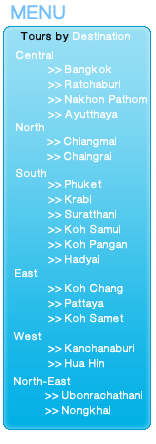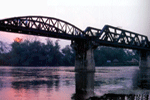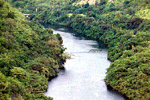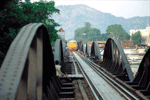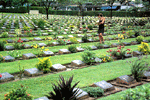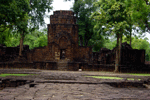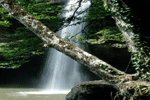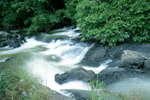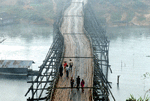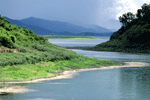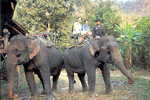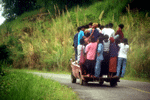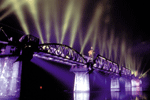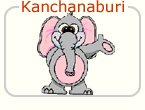|
|
Travel Infomation about Kanchanaburi, Thailand |
|
Arresting scenic beauty, Forested mountains. Waterfalls. Pristine national parks. Tranquil riverine and reservoir settings. Leisure opportunities including jungle treks employing elephants and rafts. Historical association dating from Neolithic times to the Second World War...
There are several compelling reasons for visiting Kanchanaburi. |
Thailand’s third largest province, Kanchanaburi covers some 19,473 square and oftentimes mountainous kilometres, and borders Myanmar (Burma) to the west of Bangkok. The compact provincial capital, some 130 kilometres, and a comfortable two-hour drive from Bangkok, is both the site of the world-famous Bridge Over The River Kwae, immortalised in books and movies, and gateway to a region of rugged natural beauty. Countryside beyond the provincial capital is characterised by mountains and fertile river valleys (the Kwae Yai and Kwae Noi) which have inspired the development of hydro-electric power, and where labyrinthine dam reservoirs provide further scenic elements to the province’s natural beauty.
HOW TO GET THERE
By Car
From Bangkok, visitors can take a 2-hour drive along Highway No.4 (Phetkasem) via Nakhon Chaisi, Nakhon Pathom, Ban Pong, Tha Maka, Tha Muang to Kanchanaburi.
For an alternative route, visitors can drive along Highway No. 338 from Bangkok to Nakhon Chiasi and then proceed along Highway No.4 to Kanchanaburi.
By Bus
Non air-conditioned buses leave Bangkok’s Southern Bus Terminal every 15 minutes from 4 a.m. – 8 p.m.. The trip takes about 2 hours.
There are 2 types of air-conditioned buses. Standard 1 buses (blue colour) leave Bangkok’s Southern Bus Terminal from 5 a.m. till 10.30 p.m. daily at twenty-minute intervals. Standard 2 buses (orange colour) leave at wenty-minute intervals from 5.10 a.m. until 8.30 p.m. daily. The journey takes 2 hours.
By rail
Ordinary trains leave Bangkok’s Thon Buri Railway Station (Bangkok Noi Station) every day at 7.35 a.m. and 1.45 p.m. for approximately 3 hour journey to Kanchanaburi.
The weekend special train leaves Bangkok Railway station (Hualamphong) at 6.30 a.m. on Saturdays, Sundays and public holidays. For more information.
Travel within Kanchanaburi
Transportation within the provincial capital is most enjoyable on tricycles. Tricycles can be hired at reasonable rate, enabling visitors to see the Bridge over the River Kwae, the Kanchanaburi War Cemetery, the waterfront Song Kwae Road area, and the JEATH War Museum in one circuit.
Transportation between the districts is also convenient by regular bus.
For visitors who like to drive by themselves, motorcycles or jeeps can be rented on a daily or weekly basis at several outlets on Saeng Chuto Road and around the Song Kwae Road area.
|
|
Essentially, there are two major land routes for exploring the main conveniently accessible tourist attractions in Kanchanburi. The more western Route 323 largely parallels the Kwae Noi River to Sangkhla Buri District (some 230 kilomertres from the provincial capital) via Sai Yok, Thong Pha Phum, and Vajiralongkorn Dam. Route 3199 follows the Kwae Yai River to Srinagarindra Dam (69 kilometres away from the provincial capital). |
Besides the network of roads throughout the provincial area, the railway and the waterways which stretch through the heart of town also offer comfortable and alternate trips to out-of-town attractions. Travelling by train from Kanchanaburi to Namtok Station near Sai Yok Noi Waterfall is recommended for visitors wishing to experience trips on the historic railway. Trains leave Kanchanaburi Railway Station 3 times daily at 6.11 a.m., 11 p.m. and 4.37 p.m. and stops at the Bridge over the River Kwae, Tha Kilen (near Mueang Sing Historical Park), Tham Krasae, Wang Pho and ends at Namtok Railway Station.
From the Pak Saeng Pier in Tambon Tha Sao, visitors can hire a boat with a carrying capacity of 10-12 persons to visit the Lawa Cave and Sai Yok Yai Waterfall. It takes around 4 hours for the return trip. The 1-hour boat ride to Huai Mae Khamin Waterfall starts from the Tha Kradan Pier, 12 kilometres from Srinagarindra Dam.
Visitors are advised to check with the Tourism Authority of Thailand (TAT)’s office in Kanchanaburi for prevailing rates and the availability of alternate methods of transportation such as on public holidays and weekends.
|
|
Distances from Amphoe Mueang
(Town) to Neighbouring Districts |
| |
Tha Muang
Phanom Thuan
Tha Maka
Dan Makham Tia
Sai Yok
Thong Pha Phum
Sangkhla Buri
Si Sawat
Bo Phloi
Nong Prue
Huai Kranchao
Lao Khwan |
12 km
24 km
30 km
30 km
50 km
145 km
230 km
102 km
40 km
75 km
60 km
97 km |
PLACES OF INTEREST
Amphoe Mueang (The Town and Its Outskirts)
Major tourism attractions within the provincial capital are inextricably connected with the Second World War years of 1942 through 1945 when the Imperial Japanese army occupied Thailand. |
|
The Bridge Over the River Kwae
The major landmark is the black iron bridge spanning the Khwe Yai river which was brought from Java by the Japanese army and reassembled under Japanese supervision by Allied prisoner-of-war (POW) labour as part of the ‘Death Railway’ intended to link Thailand with Myanmar. Still in use today, bridge was the target of frequent Allied bombing raids during 1945, and was rebuilt after the war ended. The curved spans of the bridge are the original sections.
|
World War II-vintage steam locomotives, and a peculiar hybrid road/railcar from the 2 same era, comprise a small open-air Railway Museum on the bridge’s eastern approach.
War Museum
The museum, located near the River Kwae Bridge, displays the collection of weapons, tools and utensils of the Allied POW and Japanese soldiers during the Second World War.
It is open daily from 8 a.m. – 6 p.m. Admission fee is 30 baht.
The JEATH War Museum
The JEATH War Museum comprise another reminder of the wartime past. The enclave, in the riverside precincts of Wat Chaichumphon, has been constructed in the form of an Allied POW camp. The name JEATH is derived from countries inextricably associated with the years 1942 through 1945, namely Japan, England, America, Australia, Thailand and Holland. The thatched detention hut with cramped, elevated bamboo bunks, contains photographic, pictorial and physical memorabilia dating from the Second World War. POWs who survived the ordeal have donated items from that period to substantiate the museum’s authenticity.
The museum is open daily from 8.30 a.m. to 6 p.m. Admission fee is 30 baht.
Kanchanaburi Town Gate
This is the remain of Kanchanaburi town built in 1831 during the reign of King Rama III. It is located on Lak Mueang Road near the meeting point of the Kwae Yai and Kwae Noi Rivers. |
|
Kanchanaburi War Cemetery Zdon Rak)
The immaculately maintained Kanchanaburi War Cemetery, opposite the main railway station on Saeng Chuto Road, contains the remains of 6,982 Allied POWs who perished during the construction of the ‘Death Railway’. An estimated 12,339 Allied POWs, and between 70,000 and 90,000 forced Asian labourers, including many Thais, died during the construction of the ‘Death Railway’ and the bridge over the River Kwae. It is believed that one out of every five people who laboured on the railway perished during its construction.
|
Chong Kai War Cemetery
A second cemetery, on the former site of riverbank Chong Kai POW Camp, contains some 1,740 remains in an equally immaculate and exceptionally tranquil and verdant setting.
Somdet Phra Srinagarindra Park
Situated in Kanchanaburi’s Agricultural College at Tambon Nong Ya, 9 kilometres from town, it is also Known as “the Stone Garden” which abounds with stones of different size and shapes.
Wat Tham Mangkon Thong
Situated 5 kilometres from town, the temple is well known for the incredible performance of the nun floating in a deep pool. There is a small museum where a variety of ancient objects found in the area are on display.
Visitors can take a Kanchanaburi – Dan Makham Tia bus and get off at the temple.
Wat Tham Phu Wa
The monastery in natural surroundings, famous for meditation, is 15 kilometres away from the provincial capital. There is a beautiful cave with plenty of stalactites.
Ancient Town of Kanchanaburi
Located at Tambon Lat Ya, 18 kilometres away from the provincial capital, this ancient border town involved in battles between the Thai and the Burmese during the Ayutthaya period to early Bangkok period. Servral ruins are found in Wat Pa Lelai, Wat Khun Phaen, Wat Mae Mai and Wat Nang Phim.
The Nine-Army Battle Historical Park
Located at Tambon Chong Sadao, some 40 kilometres from town on Highway No. 3199, the Nine-Army Battle Historical Park ware initiated by the Royal Thai Army to commemorate the great battle under the command of King Rama I, in defense of the kingdom against the aggression of King Bodawpaya of Burma in 1795. The Historical Study Building houses historical data involving this great battle, a sand table displaying battlefields and dioramas showing the battle strategy. It is open daily from 8.30 a.m. – 4.30 p.m.
Kanchanaburi Cultural Centre
The collection centre of human life styles from the past till the present is displayed at the Rajabhat Institute of Kanchanaburi, 14 kilometres out of town on the route to Sai Yok. It is open daily from 8.30 a.m. – 4.30 p.m.
Ban Kao National Museum
Some 35 kilometres from Kanchanaburi and overlooking the Kwae Noi river, the petite Ban Kao National Museum was constructed beside a Neolithic burial site discovered by an Allied POW during the construction of the ‘Death Railway’. Some 4,000 years ago, Neolithic man lived, roamed and hunted beside the Kwae rivers, sheltering beneath rock overhangs or in nearby caves. The Ban Kao museum houses skeletal remains, pots, axe heads, jewellery mad from animal bones, and other artifacts dating from that period. It is open Wednesday-Friday except public holidays from 9 a.m. – 4 p.m. Admission is 30 baht.
Amphoe Sai Yok
The Sai Yok District is 60 kilometres north of the provincial capital. Its landscape, generally rich in forests and mountains, is dotted with many natural attraction and historical places.
|
|
Prasat Mueang Sing Historical Park
Historical associations can savoured at the Prasat Mueang Sing Historical Park 43 kilometres outside the provincial capital or 6 kilometres away from Ban Kao National Museum. The ancient site is located on a steep bank of the Kwae Noi River where the waterway considerable archareological interest. The principal structure, the Khmer Prasat Mueang Sing (Tower of the City of Lions) is believed to have been the westernment outpost of the Angkor-centred Khmer empire. |
Skeletal remains dating back some 2,000 years have been unearthed, and artefacts, including temple carvings, religious statuary, implements and pottery shards indicate the once-thriving city must have been inhabited from approximately the 12th to 14th centuries A.D.
The historical park is open daily from 9 a.m. – 4.30 p.m. Admission is 40 baht.
Getting There - Visitors can take a train from Kanchanaburi to Tha Kilen Railway Station and continue on foot or by local transport to Prasat Mueang Sing, 1.5 kilometres away. Trains depart from Kanachanaburi Railway Station every day at 6.11 a.m. (arriving at Tha Kilen at 7.28 a.m.) 11 p.m. (arriving at 11.59 a.m.) and 4.37 p.m. (arriving at 5.42 p.m.). On return to Kanchanaburi, trains departs from Tha Kilen Station at 6.22 a.m., 1.51 p.m. and 4.31 p.m.
Krasae Cave
Located some 55 kilometres from Kanchanaburi, beside the surviving remnant of the ‘Death Railway’, overlooking the Kwae Noi river near Wang Pho Railway Station, this cavern contains sacred Buddha images. It can be visited on foot by walking less than 100 metres along the railway track from Wang Pho railway Station.
|
|
Sai Yok Noi Waterfall
Also known as Khao Phang Waterfall, 60 kilometres from town via Highway No. 323, this roadside cascade is best visited between July and September, when water is most plentiful.
Getting There – Non air-conditioned buses leave Kanchanaburi Bus Station every 30 minutes from 6 a.m. – 6.30 p.m. to Sai Yok Noi Waterfall. The journey takes 2 hours and costs 25 baht.
|
Alternatively, visitors can take a train from Kanchanaburi to Namtok Station and continue on foot or by local transport to the waterfall, which is 2 kilometres away. Trains depart from Kanchanaburi at 6.11 a.m., 11 a.m. and 4.37 p.m. and return from Namtok Station at 5.25 a.m. 1 p.m. and 3.15 p.m. The one-way rail trip takes about 2.5 hours and costs 17 baht. (Please check a current schedule from TAT Kanchanaburi or the railway station before departure.)
Hell Fire Pass memorial Museum
The Hellfire Pass Memorial Museum, opened on April 24, 1998, by the Australian Prime Minister, Mr. John Howard, and some 80 kilometres north of the provincial capital on Highway No.323, powerfully evokes the period when the ‘Death Railway’ was constructed. A masterful display of contemporary photographs, maps, models, illustrations and physical memorabilia from the period is complemented by a moving 7-minute audio-visual presentation.
A 4-kilometres Walking Trail permits visitors to descend to the Hellfire Pass, and then explore the ‘Death Railway’ railbed in the area. Hellfire Pass was so named because of punishing night work when flickering bonfires illuminated emaciated POWs. The cutting is some 500 metres long, and 26 metres deep. It was completed within six weeks during 1943 by Australian POWs employing hand drills, picks and shovels, baskets and dynamite.
The museum is open daily from 9 a.m. – 4 p.m. Admission is free.
Lawa Cave
Located 75 kilometres from Kanchanaburi and 50 metres from the bak of the Kwae Noi river, this large cave can be visited either by boat and by car. Chartered boats are available at the Pak Saeng Pier (southwest of Namtok Railway Station), the trip takes 45 minutes and cost 800 – 1,000 baht per boat (loading 8-10 people). Visitors travelling by road can cross the bridge at Ban Kaeenng Raboet and continue by foot. The cave contains beautiful stalactites and stalagmites in several chambers.
Sai Yok National Park
This 300-square-kilometre park contains several interesting caves and the enduringly popular Sai Yok Yai Waterfall, which flows directly into the Kwae Noi River. The idyllic beauty of the waterfall has been repeatedly celebrated in Thai poetry and song. The Daowadueng Cave, which also entails a river trip and 1-kilometre walk for visits, is an even more popular cave.
Sai Yok’s deciduous forests, including majestic teak tree, host small mammals such as squirrels, bats and deer, and numerous bird species, including wreathed hornbills and blue winged pittas. The park enjoys a maximum elevation of 1,307 metres, and is home to what is probably the smallest mammal in the world, the two grammed Kitti’s Hog-nosed Bat, which was first discovered in 1973 by a Thai naturalist.
The park is 104 kilometres from Kanchanaburi via Highway No. 323 and can also be reached by chartered boat from the Pak Saeng Pier. The park is popular during weekends, but enjoys more somnolent ambience during weekdays. Bungalow accommodation, river rafts and camping facilities, and a daytime food market are available.
Amphoe Thong Pha Phum
Thong Pha Phum is 159 kilometres north of the provincial capital. Besides limestone waterfalls which are the major attractions in the area, an overnight stay in comfortable resorts or raft-houses also offers a relaxing holiday for visitors.
|
|
Vajiralongkornn or Khao Laem Dam
This hydro-electric dam is situated on the Kwae Noi River, 6 kilometres north of Thong Pha Phum or 165 kilometres north of Kanchanaburi. The dam, 1,019 metres long and 92 metres high, forms a scenic reservoir extending to the north towards Sangkhla Buri District. Servral resorts in the form of raft houses offer opportunities for boat rides and fishing.
|
Kroeng Krawia Waterfall
This roadside waterfall, 32 kilometres north of Thong Pha Phum, is often visited by passers-by. The water cascades down a limestone rock face under shady trees. It is most beautiful during the rainy season.
Amphoe Sangkhla Buri
Dai Chong Thong Waterfall
Travel 1 kilometres along an access road off the Thong Pha Phum-Sangkhla Buri Road at Km. 32-33 and 600 metres on foot. This is rather a large waterfall which cascades down towards Vajiralongkorn Dam.
Hin Dat Hot Spring
The riverside hot spring with a pond for bathing is situated 2 kilometres off Highway No. 323 Zbetween Km.105-106). It was discovered a Japanese soldier during the Second World War. |
|
Pha Tat Waterfall
Theis huge waterfall in the western area of the Srinagarindra National Park is easily accessible. Visitors can travel north of Thong Pha Phum along Highway No. 323 and turn right at Km.105-106, then go on for 12 kilometres to the waterfall.
Thung Nang Khruan Waterfall
The waterfall is at Tambon Chala, 19 kilometres by road from Km.26 of the Thong Pha Phum-Sankhla Buri route and 30 minutes on foot. Visitors should travel with a leader to the waterfall. |
Pilok
Some 70 kilometres west of Thong Pha Phum on Route 3272, there was once much mining of wolfram and tin in the Tanaosi Mountain Range marking the Thai-Burmese border. Nowadays, temperate fruit and decorative winter plants can be seen and bought at Pilok and the villages en route. Visitors are advised to take four-wheeled drive cars for travelling along this route. Some waterfalls await adventurous visitors to explore on foot.
Sangkhla Buri
Sangkhla Buri is a predominantly mountainous and northern district of Kanchanaburi which borders Myanmar (Burma). The 224 kilometre road journey from Kanchanaburi’s provincial capital, particularly the final 7o kilometres to Sangkhla Buri district town, largely edges the picturesque Vajiralongkorn Dam reservoir, and climbs through forested mountains, offering exhilarating views of broad mountain valleys before finally descending down into the settlement which edges the reservoir’s northern extremities.
The settlement contains several guesthouses and resorts, and serves largely as a dormitory for visitors making excursions in adjacent countryside. Sankhla Buri is also the embarkation point for eco-tourism trips entailing boat rides, forest treks by elephants, and travelling by bamboo raft through picturesque riverine secnery.
Getting Therer – Sangkhla Buri is served by a daily VIP bus service originating at Kanchanaburi Bus Station which departs at 9.30 a.m., 1.30 p.m. and 3.30 p.m. On return, the VIP buses depart from Sangkhla Buri at 8.45 a.m., 10.45 a.m. and 2.30 p.m. The one-way fare is 151 baht. Air-conditioned vans make the same trip, departure times from Kanchanaburi are 7.30 a.m. 11.30 a.m. and 4.30 p.m. and departure times from Sangkhla Buri are 6.30 a.m. , 7.30 a.m., 11.30 a.m. , 1 p.m. and 3.30 p.m. The one-way fare is 118 baht. (Please check a current schedule at TAT Kanchanaburi before departure.)
Wat Wang Wiwekaram
This extensive temple on the southern outskirts of Sangkhla Buri edges on Khao Laem reservoir. The complex is constructed in an unusual mix of Thai, Indian, and Burmese Buddhist architectural styles, and the abbot ‘Luang Pho Uttama’ is highly revered among local people, including tribal folk and Burmese. |
|
Mon Bridge
Another name is “Uttamanuson Bridge”. Linking Sangkhla Buri and Mon villages, the 850-metre-long wooden bridge across the Songkaria River is a famous viewpoint overlooking the merging point of the three rivers : Songkaria, Bikhli and Ranti.
|
Three Pagodas Pass
Visitors who wish to visit the rugged Thai-Burmese border can travel by road some 22 kilometres from Sangkhla Buri to the Three Pagodas Pass, site of a small border market. Entrance is permitted to the neighbouring Burmese settlement upon payment of 10 US dollars between 8 a.m. and 6 p.m. The three miniature pagodas are memmorials to what was the traditional invasion route favoured by Burmese soldiers during the Ayutthaya period (1350 – 1767 A.D.)
Takhian Thong Waterfall
Travel along the route to the Three Pagodas Pass, then turn left at the junction and go on for 10 kilometres and take another 40-minute walk to the falls. Visitors are advised to use a four-wheeled drive care due to the road conditions.
Amphoe Si Sawat
Erawan National Park
65 kilometres from Kanchanaburi along Route 3199, this 550-square-kilometres national park is the site of the seven-tiered Erawan Waterfall, which is widely regarded as being one of Thailand’s loveliest cascades. The second tier (the highest being number seven) contain a pool ideal for swimming and is particularly picturesque. The waterfall is best seen during the late rains season months of September and October, when water is most abundant. The climb to the uppermost tiers can be punishing, and should not be attempted by those who are not completely physically fit.
The park mixed deciduous forests and waterway support a wide variety of mammals, reptiles, amphibians, birds and freshwater fauna.
The park is a popular weekend and public holiday destination, but is considerably less crowded during weekdays. Bungalow accommodation and camping facilities, and a daytime food market, are available.
Getting there – Visitors may take a bus departing from the Kanchanaburi Bus Terminal to the waterfall every 50 minutes from 8 a.m. – 5.20 p.m. It take 1 ? hours for the journey. |
|
Srinagarindra Dam
70 kilometres from Kanchanaburi, and just 4 kilometres north of the Erawan National Park, this massive structure marks the southernmost extremity of an extensive reservoir, which is part of yet another national park.
|
Phra That Cave
75 kilometres from Kanchanaburi and some 8 kilometres beyond the Erawan Waterfall, this large cave is considered to be the most beautiful in the entire province. The cave is 20 metres long and can be explored within 1 hour. Visitors can contact the Erawan National Park’s branch office situated near the cave to provide a guide to the cave.
Srinagarindra National Park
This park covers 1,532 square kilometres and is situated 105 kilometres from Kanchanaburi. The park’s relative inaccessibility necessitates a final 40-kilometre and punishing drive along a dry weather track, and negotiable only by motorcycle, pick-up trucks or 4-wheel-drive vehicles. Alternatively, the park can be accessed by a 45 to 75 minutes (depending on the vessel) boat ride from the Tha Kradan Pier. The Kradan is located 12 kilometres beyond the entrace to Srinagarindra Dam at Km. 44 of Highway 3199. A boat loading 10 people can be chartered at 1,500 baht.
Major park attractions include the lovely seven-tiered Huai Mae Khamin Waterfall which is conveniently accessible by a gradually ascending ‘user-friendly’ footpath originating near the park’s headquarters. Boat trips on the sprawling reservoir bring their own scenic rewards, and treks through encroaching deciduous forests and bamboo groves, reveal a rich variety of butterflies and bird species.
Bungalow accommodation is available. Because no restaurants as such exist, visitors are advised to bring their own food provisions. Easy Thai dishes can be cooked by park staff.
Amphoe Bo Phloi
Bo Phloi, some 40 kilometres from the provincial capital, is famed for locally mined blue sapphires and semi-precious materials such as onyx. A Jewellery Handicraft Centre enables visitors to see how these materials are fashioned into finished jewellery creations.
Getting There – Bo Phloi can be reached from Kanchanaburi by non air-conditioned bus departing from Kanchanaburi Bus Terminal every 20 minutes between 6 a.m. – 6.30 p.m. The journey takes 1 hour and costs 20 baht. |
|
Kanchanaburi Safari Park
The Safari Park, 40 kilometres from town along the Kanchanaburi-Bo Phloi route, is dominated by a man-made hill adorned with decorative pavilions. The enclave hosts numerous African and Asian mammals, including giraffes, zebras, lions, tigers and bears in carefully landscaped environs. The park adds another dimension to any excursion to Bo Phloi. The park is open daily from 9 a.m. – 6 p.m. Admission is 120 baht for adults and 60 baht for children.
|
Amphoe Nong Prue
Chaloem Rattanakosin National Park
97 kilometres from Kanchanaburi, or 22 kilometres from Amphoe Nong Prue, along Route 308t. Also known as Tham Than Lot (¶éÓ¸ÒÃÅÍ´), this 54-square-kilometre park encompasses peaceful evergreen forest, waterfalls, and several caves. Several bird species can be seen, and visitors may hear (but rarely see) the barking tree frog whose croak sounds very much like a barking puppy. There is a 2.5 kilometre nature trail along the stream which forms small cascades and flows through Than Lot Yai and Than Lot Noi Caves. There two caves have very beautiful with stalactites and stalagmites. Admission is 200 baht. Bungalow accommodation and camping facilities are available.
|
|
Getting There – Visitors can take Kanchanaburi –Nong Prue buses which depart from Kanchanaburi Bus Terminal every 20 minutes between 6.15 a.m. – 6.30 p.m. The journey takes 2 hours and costs 28 baht. From Nong Prue, chartered vans (Song Thaeo) are available to the park for another 22 kilometres (fare according to agreement). |
Amphoe Tha Muang
Wat Tham Sua and Wat Tham Khao Noi
Located at Tambon Muang Chum, 4 kilometres beyond Mae Klong Dam, these two adjacent temples house very beautiful Thai and Chinese style buildings and a huge Buddha image situated on the mount.
Amphoe Phanom Thuan
Don Chedi Archaeological Site
This is located behind Wat Thung Samo some 15 kilometres from town. The site, with the remains of a Chedi of the Ayutthaya period, was excavated by the Fine Arts Department in 1982. A hundred human skeletons, ancient swords, elephant jaw bones, and a horse riding kit were discovered.
SPECIAL INTERESTS
National Parks
Kanchanaburi contains four major national parks, namely the Sai Yok, Erawan, Chaloem Rattanakosin and Srinagarindra national parks, which can be enjoyed year-round by botanists, ornithologists, and nature lovers alike. Each park offers bungalow accommodation, complemented by rafts and –or camp sites with cold-water and simple toilet facilities. Trekking along either will-defined waterfall trails, or nature trails, to visit cascades, caves, or to appreciate local flora and fauna, is a popular activity at each of the national parks. Three of Kanchanaburi’s most picturesque waterfalls are contained within the Sai Yok, Erawan and Srinagrindra national parks.
Note: Admission to the national park is 200 baht per person. Visitors intending to make overnight stays in the national park should make reservations through the Royal Forestry Department in Bangkok. |
|
Rafting
Trips are available from the provincial capital and several holiday resorts. Raft trips leave from the famous bridge, or the song Kwae Road waterfront area and the cost depends on the duration and destination. Trips may entail 7-10 hour return journeys, or include an overnight stay on either the Kwae Yai or Kwae Noi Rivers. Visitors are advised to contact TAT’s office in Kanchanaburi for current informaiton.
|
Rail Trips
Railway enthusiasts may travel along one of Southeast Asia’s most historical tracks, namely the surviving stretch of the ‘Death Railway’, from the provincial capital to Namtok Railway Station near the Sai Yok Noi Waterfall. The winding track crosses the world famouse bridge and provides a clear indication of how difficult constructing the original track (long since repaired and restored) must have been. One particularly exhilarating stretch sees the line parallel the curving Kwae Noi River on a wooden viaduct towering above the river and hugging a steep cave-ridden cliff.
Train Schedule & Fares
Train depart from Kanchanaburi Railway Station every day at 6.11 a.m., 11 p.m. and 4.35 p.m. to Nam Tok Railway Station. On return, train leave Nam Tok station at 5.25 a.m., 1 p.m. and 3.15 p.m. Travelling time is about 2 hours. The fare is 17 baht.
Golfing
Undulating fairways and mountain backdrops characterise the terrain of most Kanchanaburi golf courses. Golfers can test their skills at eight 18-hole or 27-hole courses scattered throughout the province, and at two smaller course operated by the Electricity Generating Authority of Thailand at the Srinagarindras and Vajiralongkorn (Khao Laem) dams.
Some course are attached to resort hotels. Most have sports complexes and swimming pools, particularly important for non-playing spouses and children. Few are fully booked during weekdays, meaning that walk-ins are almost always assured that greens are available. Because of Kanchanaburi’s comparative proximity to Bangkok, bookings are recommended during weekends and public holidays. |
|
MAJOR EVENTS
River Kwae Brdge Week
Each year, late November and/or early December, the world famous bridge becomes the focal point of celebrations. Highlights include exhibitions and historical and archaeological displays; a carnival featuring sideshows, roundabouts, folk entertainment, and cultural performances; rides on trains hauled by World War II vintage steam locomotives; and a nightly light and sound presentation re-enacting the bridge’s Second World War history, including an Allied bombing raid.
|
SHOPPING
Major souvenir shops are concentrated around the eastern approaches, and reverine environment, of the world famous bridge. Almost every handicraft produced in Thailand can be purchased there. Browsing to compare quality will ensure favourable prices for readymade leisurewear and other apparel and popular souvenirs such as jewellery and handmade handicrafts. |
|

LOCAL TIME
GMT + 7 hours |
 ELECTRICITY
ELECTRICITY
220 Volts 50 cycles throughout the country. |
|

|

